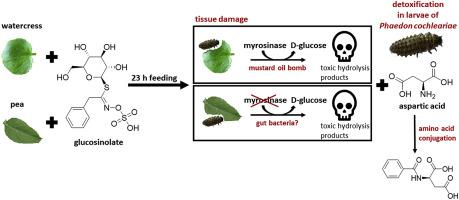Insect Biochemistry and Molecular Biology ( IF 3.2 ) Pub Date : 2020-07-10 , DOI: 10.1016/j.ibmb.2020.103431 Jeanne Friedrichs 1 , Rabea Schweiger 1 , Svenja Geisler 1 , Andreas Mix 2 , Ute Wittstock 3 , Caroline Müller 1

|
Plants of the Brassicales are defended by a binary system, in which glucosinolates are degraded by myrosinases, forming toxic breakdown products such as isothiocyanates and nitriles. Various detoxification pathways and avoidance strategies have been found that allow different herbivorous insect taxa to deal with the glucosinolate-myrosinase system of their host plants. Here, we investigated how larvae of the leaf beetle species Phaedon cochleariae (Coleoptera: Chrysomelidae), a feeding specialist on Brassicaceae, cope with this binary defence. We performed feeding experiments using leaves of watercress (Nasturtium officinale, containing 2-phenylethyl glucosinolate as major glucosinolate and myrosinases) and pea (Pisum sativum, lacking glucosinolates and myrosinases), to which benzenic glucosinolates (benzyl- or 4-hydroxybenzyl glucosinolate) were applied. Performing comparative metabolomics using UHPLC-QTOF-MS/MS, N-(phenylacetyl) aspartic acid, N-(benzoyl) aspartic acid and N-(4-hydroxybenzoyl) aspartic acid were identified as major metabolites of 2-phenylethyl-, benzyl- and 4-hydroxybenzyl glucosinolate, respectively, in larvae and faeces. This suggests that larvae of P. cochleariae metabolise isothiocyanates or nitriles to aspartic acid conjugates of aromatic acids derived from the ingested benzenic glucosinolates. Myrosinase measurements revealed activity only in second-instar larvae that were fed with watercress, but not in freshly moulted and starved second-instar larvae fed with pea leaves. Our results indicate that the predicted pathway can occur independently of the presence of plant myrosinases, because the same major glucosinolate-breakdown metabolites were found in the larvae feeding on treated watercress and pea leaves. A conjugation of glucosinolate-derived compounds with aspartic acid is a novel metabolic pathway that has not been described for other herbivores.
中文翻译:

叶甲虫Phaedon cochleariae幼虫中的新型芥子油苷代谢。
十字花科植物受到二元系统的防御,其中芥子油苷被黑芥子酶降解,形成有毒的分解产物,如异硫氰酸盐和腈。已经发现了各种排毒途径和避免策略,它们允许不同的草食性昆虫类群处理其寄主植物的芥子油苷-黑芥子酶系统。在这里,我们调查了十字花科植物的摄食专家叶甲虫种(Phaedon cochleariae(Coleoptera:Chrysomelidae))的幼虫如何应对这种二元防御。我们使用豆瓣叶(金莲花,含2-苯基乙基芥子油苷作为主要芥子油苷和黑芥子酶)和豌豆(豌豆叶)进行了饲喂实验。,不含硫代葡萄糖苷和黑芥子酶),对其应用苯甲硫代葡萄糖苷(苄基或4-羟基苄基硫代葡萄糖苷)。使用UHPLC-QTOF-MS / MS进行比较代谢组学研究,确定N-(苯乙酰基)天冬氨酸,N-(苯甲酰基)天冬氨酸和N-(4-羟基苯甲酰基)天冬氨酸是2-苯基乙基-,苄基-的主要代谢产物。幼虫和粪便中的芥子油苷和4-羟基苄基芥子油苷。这表明的是幼虫P. cochleariae将异硫氰酸酯或腈代谢为衍生自摄入的苯甲酸芥子油苷的芳香酸的天冬氨酸共轭物。黑芥子酶测定显示仅在用豆瓣菜喂养的二龄幼虫中有活性,而在用豌豆叶喂养的新鲜蜕皮和饥饿的二龄幼虫中没有活性。我们的结果表明,预测的途径可以独立于植物黑芥子酶的存在而发生,因为在以处理过的豆瓣和豌豆叶为食的幼虫中发现了相同的主要芥子油苷分解代谢产物。芥子油苷衍生的化合物与天冬氨酸的结合是一种新颖的代谢途径,尚未针对其他草食动物进行描述。











































 京公网安备 11010802027423号
京公网安备 11010802027423号